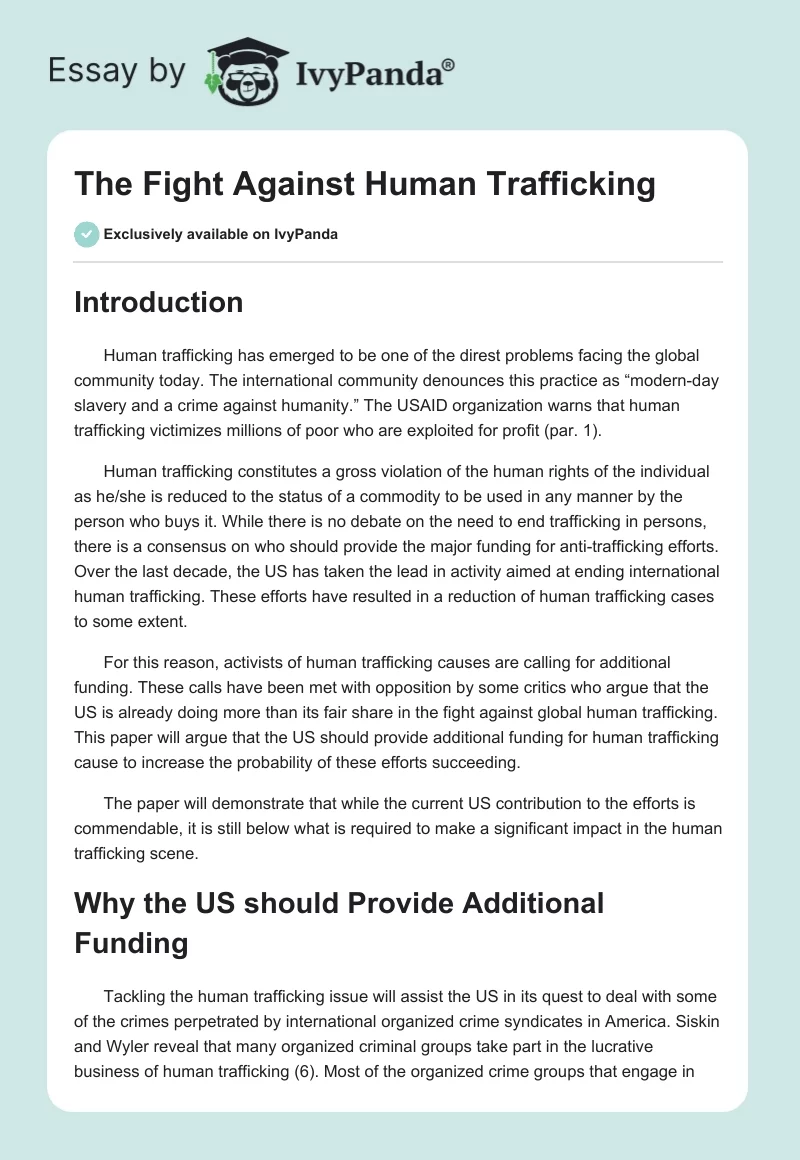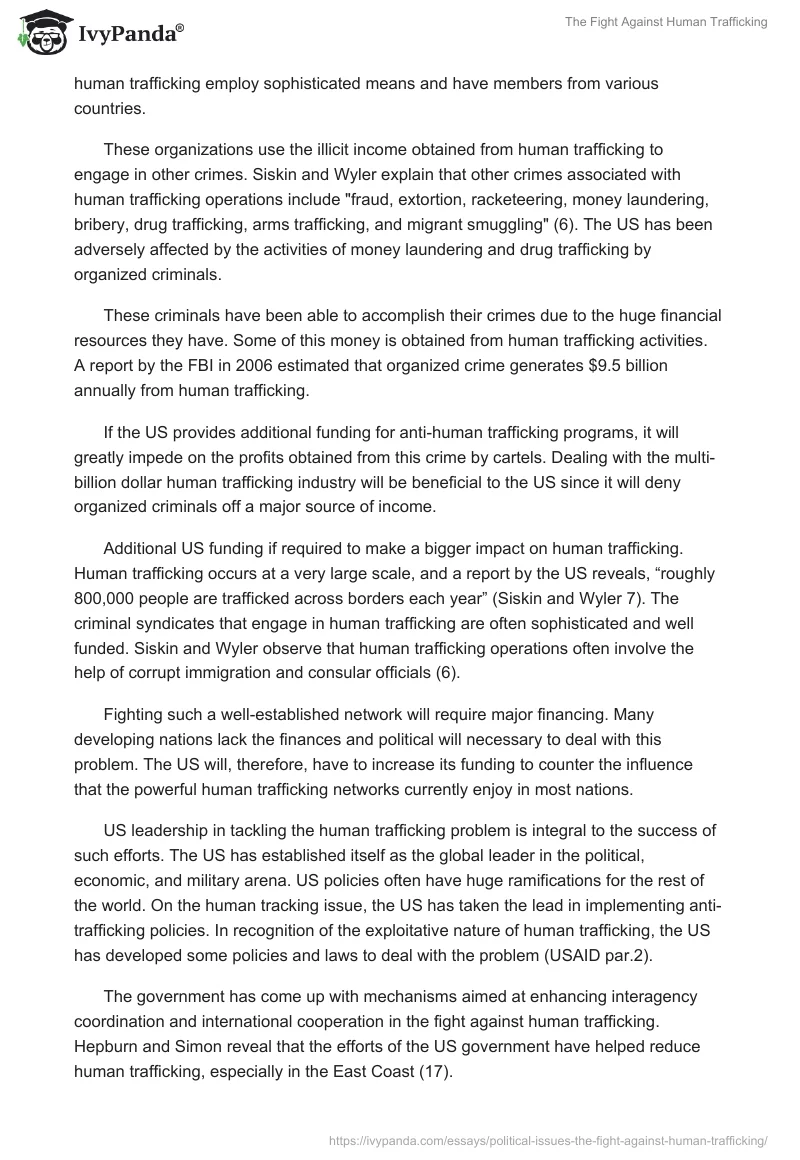Introduction
Human trafficking has emerged to be one of the direst problems facing the global community today. The international community denounces this practice as “modern-day slavery and a crime against humanity.” The USAID organization warns that human trafficking victimizes millions of poor who are exploited for profit (par. 1).
Human trafficking constitutes a gross violation of the human rights of the individual as he/she is reduced to the status of a commodity to be used in any manner by the person who buys it. While there is no debate on the need to end trafficking in persons, there is a consensus on who should provide the major funding for anti-trafficking efforts. Over the last decade, the US has taken the lead in activity aimed at ending international human trafficking. These efforts have resulted in a reduction of human trafficking cases to some extent.
For this reason, activists of human trafficking causes are calling for additional funding. These calls have been met with opposition by some critics who argue that the US is already doing more than its fair share in the fight against global human trafficking. This paper will argue that the US should provide additional funding for human trafficking cause to increase the probability of these efforts succeeding.
The paper will demonstrate that while the current US contribution to the efforts is commendable, it is still below what is required to make a significant impact in the human trafficking scene.
Why the US should Provide Additional Funding
Tackling the human trafficking issue will assist the US in its quest to deal with some of the crimes perpetrated by international organized crime syndicates in America. Siskin and Wyler reveal that many organized criminal groups take part in the lucrative business of human trafficking (6). Most of the organized crime groups that engage in human trafficking employ sophisticated means and have members from various countries.
These organizations use the illicit income obtained from human trafficking to engage in other crimes. Siskin and Wyler explain that other crimes associated with human trafficking operations include “fraud, extortion, racketeering, money laundering, bribery, drug trafficking, arms trafficking, and migrant smuggling” (6). The US has been adversely affected by the activities of money laundering and drug trafficking by organized criminals.
These criminals have been able to accomplish their crimes due to the huge financial resources they have. Some of this money is obtained from human trafficking activities. A report by the FBI in 2006 estimated that organized crime generates $9.5 billion annually from human trafficking.
If the US provides additional funding for anti-human trafficking programs, it will greatly impede on the profits obtained from this crime by cartels. Dealing with the multi-billion dollar human trafficking industry will be beneficial to the US since it will deny organized criminals off a major source of income.
Additional US funding if required to make a bigger impact on human trafficking. Human trafficking occurs at a very large scale, and a report by the US reveals, “roughly 800,000 people are trafficked across borders each year” (Siskin and Wyler 7). The criminal syndicates that engage in human trafficking are often sophisticated and well funded. Siskin and Wyler observe that human trafficking operations often involve the help of corrupt immigration and consular officials (6).
Fighting such a well-established network will require major financing. Many developing nations lack the finances and political will necessary to deal with this problem. The US will, therefore, have to increase its funding to counter the influence that the powerful human trafficking networks currently enjoy in most nations.
US leadership in tackling the human trafficking problem is integral to the success of such efforts. The US has established itself as the global leader in the political, economic, and military arena. US policies often have huge ramifications for the rest of the world. On the human tracking issue, the US has taken the lead in implementing anti-trafficking policies. In recognition of the exploitative nature of human trafficking, the US has developed some policies and laws to deal with the problem (USAID par.2).
The government has come up with mechanisms aimed at enhancing interagency coordination and international cooperation in the fight against human trafficking. Hepburn and Simon reveal that the efforts of the US government have helped reduce human trafficking, especially in the East Coast (17).
However, human trafficking is yet to be mitigated substantially. The greater success of the US-led efforts against human trafficking can only be assured if additional funding is provided to this task. Once positive results are attained, it can be expected that other nations will be willing to commit increased financing to their anti-human trafficking efforts.
Objections and Refutations
Arguments have been made that the US is already doing more than all the other countries to tackle human trafficking. The financial contribution made by the US to address the issue has been substantial compared to the contribution made by other nations. This is in spite of the fact that human trafficking is not a uniquely US problem but rather a global problem. This argument is supported by the fact that human trafficking is a global problem that affects 161 nations around the world (Kaneti, 345).
Other nations, therefore, need to make a more solid contribution to anti-trafficking efforts instead of expecting the US to increase its already substantial contribution. While it is true that the US makes a major financial contribution to anti-trafficking programs, the fact is that most of the other countries lack the financial resources that the US has. Human trafficking is most rampant in developing countries that do not have adequate finances to deal with basic concerns such as healthcare and education, let alone fighting human trafficking.
Opponents of increased US funding suggest that the US should not be obliged to use its resources to solve the problems of other nations. Such critics argue that the international community should be grateful for the effort that the US makes to solve problems that mostly affect third world countries. The reality is that human trafficking mostly takes place in developing countries where people have limited economic opportunities.
However, this activity causes problems to a developed nation such as the US. It is true that the US is the biggest single contributor to anti-human trafficking efforts in the world. However, it should be remembered that the US is also the choice destination for many of the trafficked individuals. Kaneti asserts that the US and parts of Western Europe are the choice destination countries for many human traffickers (352).
This fact is corroborated by Hepburn and Simon, who state that the US is one of the top 10 destinations for human trafficking with tens of thousands of people trafficked into the county each year. As such, human trafficking contributes to the problem of illegal immigrants that the US currently faces.
The preference of these destinations is that they provide socio-economic opportunities that the trafficked persons lack in their home country. It is therefore evident that while human trafficking is prevalent in developing nations, the US is directly affected by this activity. Additional funding will help mitigate this practice and therefore, reduce the problems that human trafficking causes to the US.
Conclusion
Currently, the US has the most elaborate program and acts as the major financier of anti-trafficking efforts. This paper has argued that the US should increase its funding to anti-human trafficking efforts. It began by highlighting how rampant the problem of human trafficking has become in modern society. It then discussed how the US had taken a leadership role in combating this global problem. It noted that by increasing funding, the US would reduce the power of organized crime and mitigate human trafficking.
The paper has noted that the US will benefit from a successful anti-trafficking program since the country is a choice destination for many of the trafficked individuals. The paper has acknowledged that human trafficking is a global problem that requires the input of all the nations of the world.
However, the US will have to play a leadership role and set the standard for the other nations. By doing this, the degrading practice of human trafficking will be stopped, and people will be able to live a fulfilling life without having their human rights violated for profit.
Works Cited
Hepburn, Stephanie & Simon Rita. “Hidden in Plain Sight: Human Trafficking in the United States.” Gender Issues 27.1 (2010): 1–26. Web.
Kaneti Marina. “Project Trafficking: Global Unity in Addressing a Universal Challenge?” Hum Rights Rev 12.1 (2011): 345-361. Print.
Siskin, Alison & Wyler Liana. Trafficking in Persons: U.S. Policy and Issues for Congress. Washington, DC: Congressional Research Service. Print.
USAID. Countering Trafficking in persons. 2013 Web.


